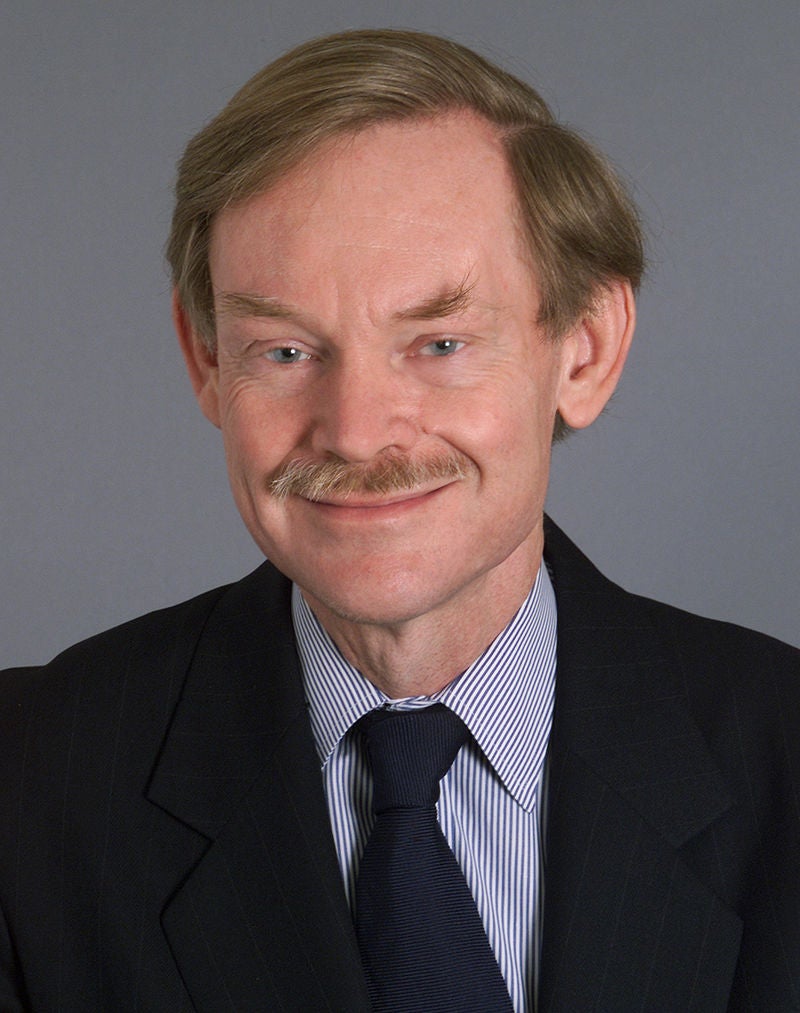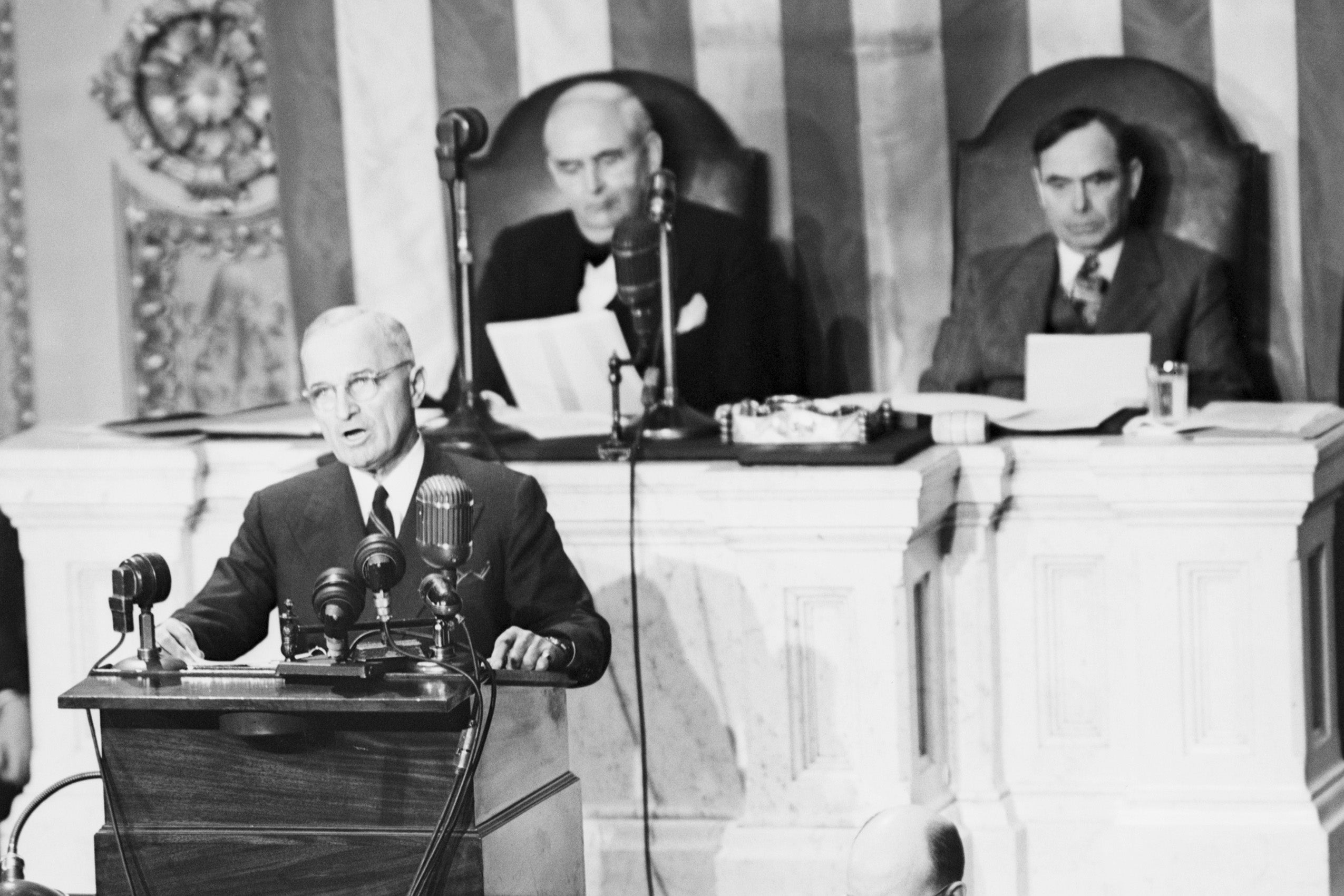In March 1947, U.S. President Harry Truman announced to a joint session of Congress a new foreign policy aimed at preventing the Soviet Union from expanding its control over nearby free nations.
“I believe that it must be the policy of the United States to support free peoples who are resisting attempted subjugation by armed minorities or by outside pressures,” Truman told members of Congress crowded into a packed House of Representatives chamber. He never mentioned the Soviet Union by name, but his pronouncement became the foundation of U.S. foreign policy for containing Russian and communist expansion for the remainder of the Cold War.
For Robert Zoellick ’81, an alumnus of both Harvard Law School and Harvard Kennedy School, what became known as the Truman Doctrine marked a dramatic shift from the nation’s traditional reluctance to involve itself continually in international affairs — an aversion born from George Washington’s warnings against “permanent alliances” in the Farewell Address he delivered when stepping down from the presidency in 1796.

“I think that the larger implication of the Truman Doctrine is the expectation of global leadership that is intrinsic to U.S. foreign policy today,” says Zoellick, the former state department deputy and undersecretary, deputy White House chief of staff, U.S. trade representative and World Bank president. “These events propelled the United States to the role of alliance leader and sponsor of an international economic system, which for good or ill together define our involvement in the world today.”
Zoellick, the author of “America in the World: A History of U.S. Diplomacy and Foreign Policy,” believes that understanding the origins and impact of the Truman Doctrine requires an examination of the historical context from which it sprang — a post-war world in which the U.S. government felt compelled to take on a new leadership role.
“When Harry Truman became president in 1945, Americans wanted to come home [from war],” he says. General Dwight D. Eisenhower “expected that U.S. troops would all be home within two years,” a prediction that missed by some 75 years and counting. Gallup polls from the time show that Americans had little interest in making foreign affairs a national priority.
The new administration attempted to lead the domestic transition from war to peace, while keeping a wary eye on what appeared to be a rising Soviet threat. Winston Churchill warned in 1946 of an Iron Curtain across half of Europe, but major newspapers criticized Churchill. Nevertheless, America’s leaders were mindful of lessons they’d learned at the end of the Great War a quarter century earlier.
“It’s important to recognize the common experience of Truman, his advisors, and the Congress,” Zoellick explains. “They had hoped to learn the lessons of the ’20s and ’30s about avoiding economic breakdown and blocks, which led to fascism, militarism, and war. They believed appeasement had failed. And they understood that a successful U.S. foreign policy needed Congressional and public support.”
The immediate genesis of the Truman Doctrine came on February 21, 1947, when the British Embassy informed the U.S. government of plans to withdraw its aid and 40,000 troops from Greece and Turkey within six months. Greece was close to “the brink of a collapse” and facing economic crises and a communist insurgency. Turkey struggled to modernize its military and economy while facing pressures from the Soviets. Exhausted by war, Great Britain could no longer play its traditional role of helping secure international peace around the globe.
“Geopolitically, the fall of Greece would surround Turkey, and Turkey and Greece together were the key to the eastern Mediterranean, energy supply lines, and strategic air bases,” Zoellick says. The inter-war years had caused great doubt about democratic systems of government, economies were devastated, publics were fearful, and “communism was on the rise in Western Europe,” as well as in China.
In a White House meeting six days later, Secretary of State George Marshall, who had led the U.S. war effort under President Franklin Delano Roosevelt, tried but failed to convince skeptical congressional leaders that the U.S. needed to come to both nations’ aid. But the tide turned when Undersecretary of State Dean Acheson, who graduated from Harvard Law in 1918, asked to speak. “Acheson reframed the topic,” Zoellick says. “He shrewdly picked up on the senators’ visits to Europe where they had seen the devastation and Soviet influence. Acheson warned that Moscow was enveloping and probing for weakness. … ‘[T]he Soviets are gambling at minimal cost, and the U.S. will either act boldly, or it will lose by default.’”
After a long silence, Zoellick says, Senator Arthur Vandenburg — a Republican who chaired the Senate Foreign Relations committee and with whom Truman had worked to build bridges since the GOP swept the House and Senate in 1946 — spoke up: “‘Mr. President, if you say that to Congress, and to the country, I will support you, and I believe most members will do the same.’”
“This was just the start,” Zoellick observes. “They didn’t even have a plan. Remember, this is just six or seven days after receiving these notes [from the British].” Instead of looking to increase aid, he says, the new Republican Congress was hoping to cut spending. “So, the context was not auspicious for what Truman had to do.”
But within two weeks of the meeting and three of learning of the British plans to withdraw from Greece and Turkey, Truman was standing on the rostrum in the House chamber announcing the most significant change in U.S. foreign policy in American history. “For 150 years, the United States had avoided entanglements with Europe and permanent alliances,” Zoellick explains. “And so, this was a huge historical turning point. Truman didn’t mention the Soviet Union even once. He mentioned communism only once. He drew a word picture of countries at risk. Truman emphasized the need to create conditions in which people could build ways of life free from coercion. He shrewdly compared his request with the $341 billion that the United States had just spent in World War II.”
Truman emphasized the need to create conditions in which people could build ways of life free from coercion.
The implications of this revolutionary new strategy were impossible to predict or fully fathom at the time. “Now the question, of course, immediately arises — and this is what historians have been debating for 75 years: How far would this doctrine reach? To Korea, to Vietnam, to Taiwan, to Berlin? And how would it be accomplished? People forget, given the later military role of the United States in Europe through NATO, that at this point Truman focused primarily economic and financial assistance. And what would be the restraints? How far would the United States go in supporting free peoples?”
Can the conflicts that ensued – most notably, the Vietnam War – be laid at Truman’s feet? “I think it’s a little unfair to hold Truman responsible for every mistake afterwards because political leaders have to make their own decisions in changing contexts about purposes, means, and public support,” Zoellick says. “On the other hand, doctrines such as the Truman Doctrine do become verbal weapons. They’re used by editorialists saying, ‘if Truman stood for freedom for Greece and Turkey and Europe, why shouldn’t it do the same elsewhere in the world?’”
Events moved swiftly. Vandenberg ushered the economic aid package for Greece and Turkey through Congress, putting a bill on Truman’s desk by May 1947. In June of that year, at a speech at Harvard University, Marshall announced his economic rescue plan for Europe. But the Marshall Plan could not work without the economic revival of Western Germany. The Federal Republic of Germany was created in 1948 and 1949 from the three zones occupied by the U.S., Great Britain, and France. In 1948, the Soviet Union blockaded Berlin which, though free from Russian control, lay within its occupation zone. Truman gambled that he could keep Berlin alive with a heroic airlift — and won.
“Finally, in addition to the Truman Doctrine, Marshall Plan, and the creation of West Germany, we have the last critical step, which is a recognition of the need for the North Atlantic Alliance — the military alliance that America had hoped to avoid,” Zoellick says. In the two years between February 1947, when the British announced their planned pullout from Greece and Turkey, to the formation of NATO in April 1949, the foundations of the Cold War were cemented. But many participants agreed later that 1946 was the critical year in shaping Truman’s thinking.
“In Truman’s memoirs, he refers to 1946 as a year of decision,” Zoellick says. “I think Acheson is more accurate in describing it as a year of learning.”
In 1950, North Korea invaded its southern neighbor, igniting the first hot conflict of the Cold War. Truman decided to defend South Korea, which like parts of Germany had been administered by the U.S. after the war. Under the auspices of the United Nations, Truman’s Doctrine had been extended from providing economic to full-scale military support to nations under threat. Though an armistice was signed in 1953, a state of war continues to this day. The Korean War prompted the United States to reinforce NATO with large U.S. forces stationed in Europe, where they remain on guard today.
How do historians view the Truman Doctrine today? “I think the general assessment is that Truman began the U.S. political, military, and economic commitments of the Cold War,” says Zoellick. But he notes that every president throughout that period had to confront his own challenges and make his own decisions. “Eisenhower tried to calm and prepare Americans for a long struggle. John F. Kennedy had to figure out what to do with Berlin and Cuba, the first crisis of nuclear intimidation. Lyndon Johnson and Richard Nixon had to deal with Vietnam. And then for Nixon, the reopening to China; Jimmy Carter struggled with Moscow’s aggression; Ronald Reagan’s military build-up and negotiations; and George Herbert Walker Bush’s — Bush 41’s — peaceful end of the Cold War in Europe, with which I was involved when working for Secretary of State James Baker.”
As President Joe Biden confronts Russia’s 2022 invasion of Ukraine and the resulting threat to European and global peace, Zoellick argues Biden too will need to decide a host of uncomfortable questions with few obvious or good answers.
“Consider similar questions in today’s context: Will the U.S. be willing to fight for Ukraine? Or will it help Ukraine defend itself? That’s the dividing line that President Biden is trying to draw,” he says. “What does it mean for NATO’s neighbors in the East … particularly if there’s an ongoing insurgency in Ukraine, with military supplies shipped across NATO’s eastern borders?”
And what about economic power? “We’ve seen the tremendous effect of the sanctions on Russia,” he says, but is there a role for the positive use of economics too, such as the Marshall Plan and the open trading system that drew others closer to America while boosting global growth and development. And where will China stand? “Are we now confronting a new axis of aggressive autocracies or —considering that 2022 is also the 50th anniversary of the Shanghai communique and Nixon’s trip to China — is there an ability to differentiate between these two authoritarian countries?”
Ultimately, Zoellick says that, like Truman before him, Biden will have to decide the biggest questions: “Are we returning divisions, such as those in the Cold War? Or might the world look more like the contest of powers at the dawn of the 20th Century? Will the U.S. lead, and if so, how?” Whatever the choices, Zoellick suggests, history helps us pose questions as America considers what course to set.
